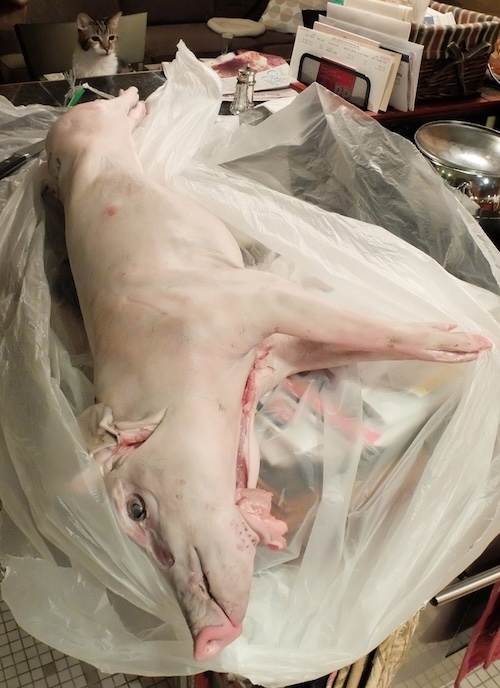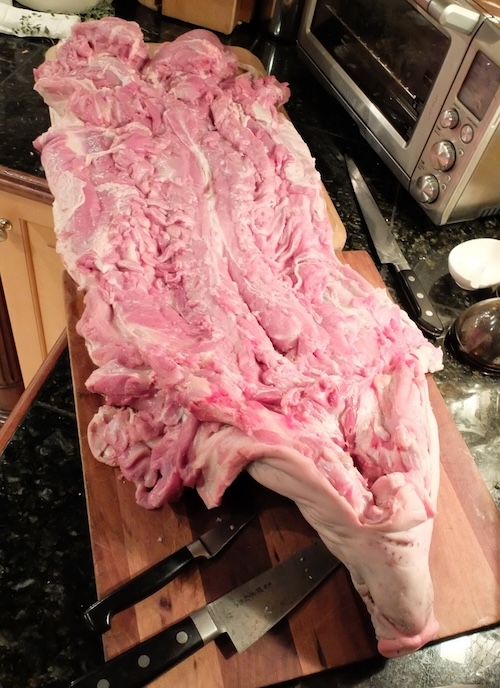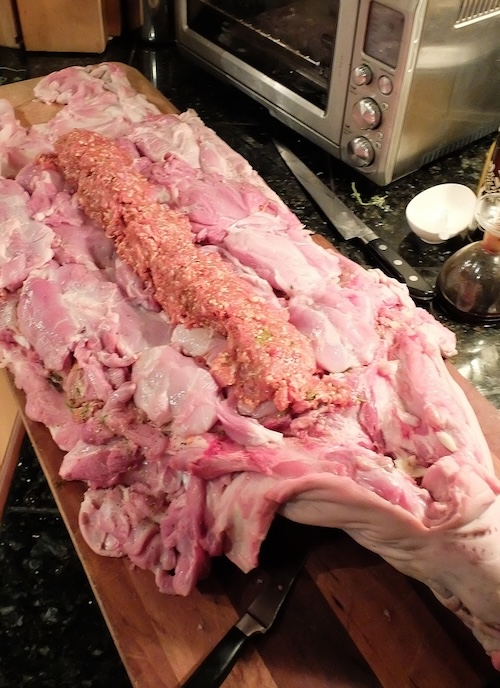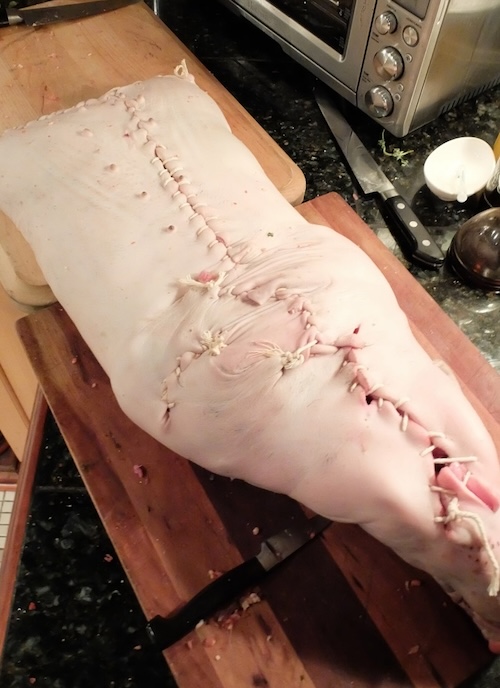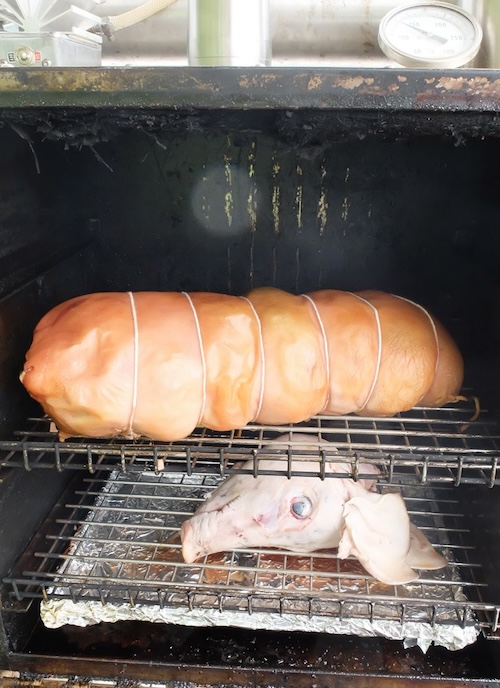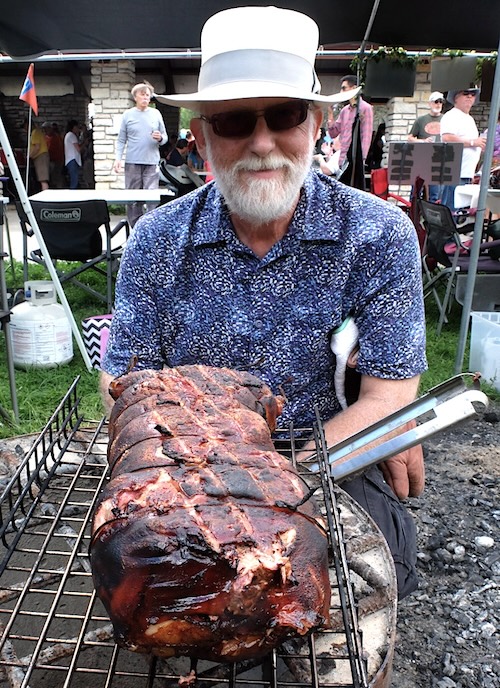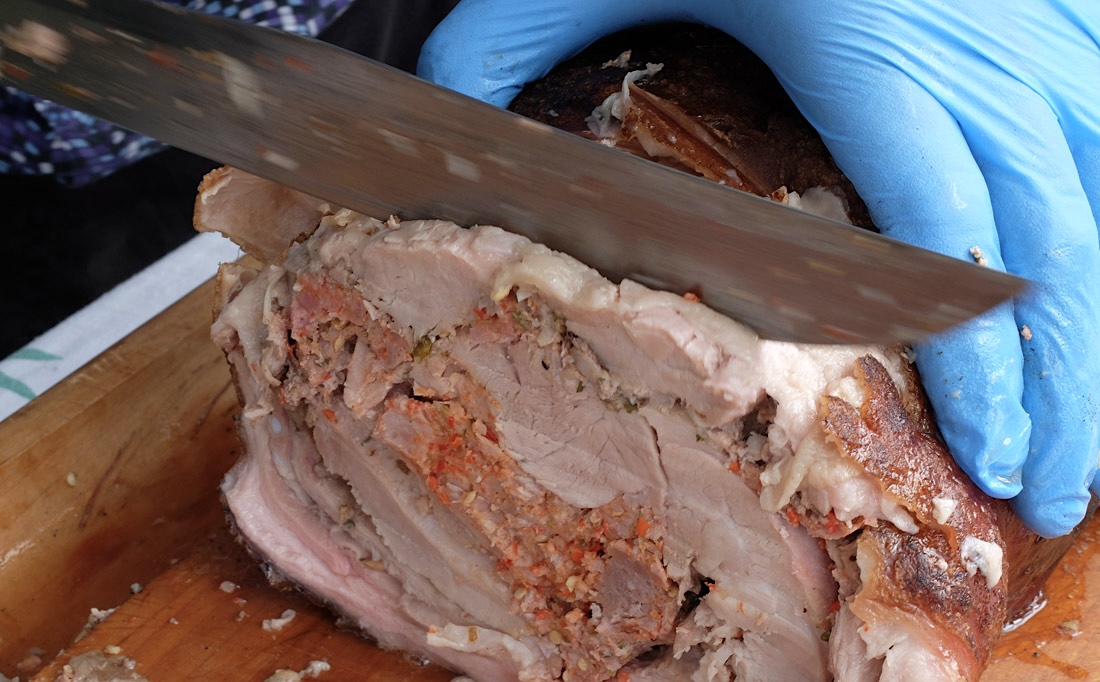© 2016, Randy Mosher
This is the Italian dish, most famous in Emilia-Romagna, featuring a whole pig, boned out and stuffed with its own meat and herbs, roasted and typically sliced into slivers and served as rustic sandwiches. Having done a variety of “fake” porchetta creations in the past, I thought it would be fun to try to the real deal for the recent Chicago Beer Society picnic’s “Other Meat” category.
First up, find a small pig. When you live in a meat paradise like Chicago, it’s not too hard, and a call by my barbecue partner to Halstead Packing company turned up a 27-lb. pig with my name on it.
There’s nothing too complicated about boning it out, although it is a bit tedious. It took close to three hours by the time I got it stuffed and all stitched up. First, sharpen your knife. It really makes a huge difference. Although I had a larger Japanese butcher knife, I found I got most of the work done with a small hook-beaked parer. On a pig that small, the bones are none too big and the sharp point got right into the tendons, freeing up the joints.
I started with the back legs. Hit those tendons at the hips and you can feel the legs loosen up, then just keep working the material that holds the joints together. There is no need to use a saw or a cleaver at any point of the project. The hams were going to be used to stuff inside, so I pulled them all the way off.
Front legs next. Cut them off at the knee but just pull the bones out leaving the meat attached to the skin. I ended up leaving the shoulder blades in, and they were easy enough to work loose when the thing was cooked.
Then, cut along both side of each rib and work them loose with your fingers, and eventually pop them out where they’re attached to the backbone, one by one. Then work under and around the spine, being careful to avoid cutting through the skin at the top of the back where it’s close to the bone. I left the head on for the effect until I realized it was too long to fit in my smoker (oh, damn), so I ended up taking it off and cooking it separately.
I cut the hams into chunky strips with the grain so I could lay them into the cavity and get a nice round form. My friend Jonathan grows a particular sort of Brazilian chile called a biquinho, which in its home is pickled and served as a bar snack. It has a deeply fruity habañero aroma with a mere tickle of heat. They were the main seasoning, along with Mexican oregano, coriander, salt, pepper and plenty of fresh garlic. I sprinkled the spices onto the meat and also mixed it into some fresh Italian sausage which was the mortar used to hold the meat inside.
I used some heavy cotton butcher twine to hold the roll in place before stitching. I used a large surgical/ taxidermy needle and the same twine to stitch the whole thing up, tight like a baseball. The skin is tough, and while my needle has a cutting edge, the hole it punched was too small to pull the double width of twine through, so I ended up using my little knife to make small slits in the skin about every inch for the stitching.
The needle goes up from the bottom, across the seam, under and then up, then back under on the next side. Draw it up nice and tight. It’s not absolutely necessary to stitching, as you can just fasten with lots of circles of twine. Stitching, however, does a much better job of making a watertight package that holds inn the moisture, helping keep the leg and loins meat juicy. I have seen videos of people piercing the skin of larger porchettas (like 100+ lb pigs), but it was not necessary on this one.
Once stitched, mine was a little flat, so I added a loop of butcher twine every inch-and-a-half or so, and than neatened up the roll. Here it is from the top, ready to bake—or would have been, had it fit into my oven or smoker.
You can roast this in your household oven (as long as it will fit) or smoke-roast; either way is good. I stuck it in the oven to get a little heat on as I packed everything else up and loaded the car for the event. 1.5 hours at 325°, convection roast setting.
At the event, the porchetta went on the smoker about 9:30 and came off about 1:30, on wild cherry wood, around 225°F, ending up with an internal temperature of 170°. Not high enough for pulling, but plenty done.
The final step was crisping up the skin with a propane torch. Working in sections, it took just a few seconds to bubble up the skin and make it nice and crispy. It looked a little like it was burning and was fairly dark at the end, but it did not taste the least bit burnt. The twine cords mostly burned off in the process, but the shape was set by then and they weren’t needed at that point.
Slice into crescent-shaped slivers. It helped to kind of break up the crisp skin with a knife point before slicing. We served on small rolls with some biquinho chile salsa Jonathan made. Delicious—and we ended up winning the competition as well.
Thanks to my BBQ partner for this adventure, Jonathan Levin, and our wives Nancy and Pam for tolerating (and even assisting with) such a ridiculous project.
Below, top to bottom, left to right: 1) The beastie came in from the car accompanied by intense interest from Chester the cat 2) Deboned – the pig, not Chester 3) With sausage and hams, before rolling 4) Underside stitched up 5) Here’s the pig just going into my homemade smoker, The Porktronic 3500 6) Finished 7) Takin’ home the trophy
